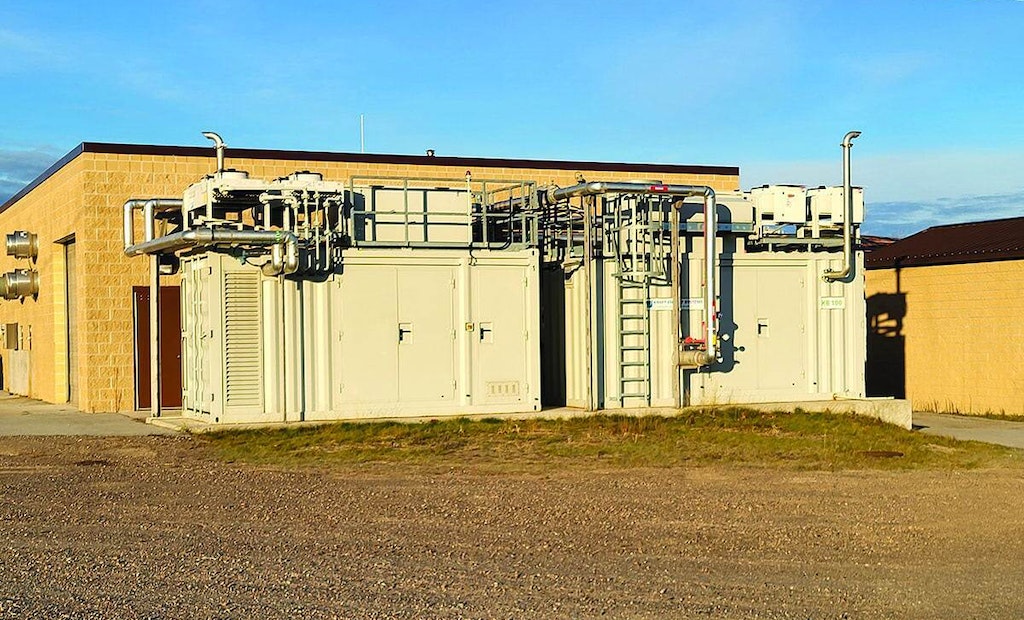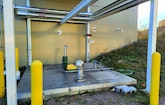
The two 100 kW generators at the food waste processing building at the Kinross Wastewater Treatment Plant produce heat and power.
Interested in Energy?
Get Energy articles, news and videos right in your inbox! Sign up now.
Energy + Get AlertsGreg Wright has found that the path to energy self-sufficiency has many obstacles for rural clean-water plants.
That hasn’t discouraged him from continuing the journey. It has forced him to be patient.
“That, to me, is the ultimate goal, to get to the point where we are at least net zero, where it doesn’t cost us any energy to operate the plant,” says Wright, wastewater superintendent in Kinross, Michigan.
Kinross is the site of a former U.S. Air Force base in the Upper Peninsula. The plant serves a population of about 6,000, including two state prisons. The prisons produce about 75% of the flow to the wastewater treatment plant (2 mgd design, 0.5 mgd average).
It’s a trickling filter plant with four rectangular clarifiers, used two at a time. Chlorine is dosed for disinfection, and ferrous chloride is added to remove phosphorus and suspended solids. In secondary treatment, sodium hydroxide is used for pH adjustment. The effluent flows into a swamp and then to a creek that flows into the Whiskey River. Biosolids are land-applied.
In recent years, the plant has added a second digester and equipment to remove hydrogen sulfide and siloxanes from the biogas produced in the digesters. Also recently added are two 100 kW generators (KB 100) for the combined heat and power system, a FOG receiving station and processing equipment for the food waste that boosts methane production.
Facing limitations
Only one digester is enough at this point; the second one is used to store and settle the biosolids from the first digester. The supernatant fluid is pumped back to the plant headworks. Then the solids are pumped to an old digester that was part of the original Air Force base plant, and the supernatant again is pumped back to the front. Use of additional digesters in this way has reduced biosolids volume significantly, cutting down land application costs.
Because of the plant’s location, food waste sources are limited. The area has no large food processing plants, food distributors or waste food distributors. Originally, Kinross had an arrangement with a garbage collection company to deliver food waste, but that plan evaporated when the local hauler was bought out and the new owner wasn’t interested.
“That threw a pretty big wrench into our plans,” Wright says. “We had to figure out some way to collect the food waste, and that’s when we decided to get our own truck (Mack) and containers (Ameri-Kan Container Service).”
Now Kinross places containers at the prisons and at Lake Superior State University in the nearby city Sault Ste. Marie. Workers at those places fill the containers with trash bags, and treatment plant staff members pick them up.
Trouble with bags
Kinross has equipment to separate the garbage from the bags, but often bags get wrapped up in the machinery. “The bags tend to stretch and wrap around the feed screws, and pretty soon it renders the machine incapable of feeding and separating the food waste,” Wright says.
“Sometimes an hour of processing means four hours of maintenance just cleaning it out so we can run it again. That’s been our No. 1 problem. We are trying some other ideas to see if we can cut that down to a lower maintenance time. If another community was looking at this, the most important thing I could tell them would be to find sources that don’t involve bags. Good, clean sources of food waste are an absolute necessity for this process to be successful.”
Despite the processing issues, the food waste has boosted methane production significantly, and Wright is trying to locate more sources. He’s also planning to mix FOG into the digesters: “We want to see what results we can get from that because in our situation, a best-case scenario would be to run FOG, if we can get enough of a source. It’s a much simpler process receiving that compared to food waste.”
Another issue with the food waste is consistency. The bags’ contents can vary significantly. It’s not as consistent as, for example, waste from a vegetable processing plant or dairy plant or a brewery. The inconsistencies could lead to problems that show up in the effluent.
“That is why I say that patience is a virtue,” Wright says. “Obviously, we want to move forward and keep trying to make the project succeed. But, like everywhere, we have permit limitations that we have to stay within, and that’s always going to be the No. 1 priority.”
Not enough power
Even with the boost in methane, the plant doesn’t produce enough to generate a lot of power.
“Compared to what we’re putting into it at this point, it’s costing us money, if you look at man-hours and equipment and everything,” Wright says. “I know we’re not running enough even to recoup our cost right now.”
But Wright can envision a day when the tide will turn and the combined heat and power project will be a good investment. He’s looking to bring in a new source of clean food waste. His first goal is to produce enough methane for one of the generators to run 24 hours a day all week.
That’s important not just for power production, but for heat, especially in winter. “There’s not a part of this process that doesn’t take some sort of power,” he says. “It requires energy to run. “You’ve got to produce enough energy to match what you’re using to process food waste, but then you’ve got to go above and beyond that to end up at net zero.
“It can be a tall order. We have two big limitations because of our location and the size of our system. The No. 1 thing would be the sources of food waste, and that’s because of our location, being a rural community.”







